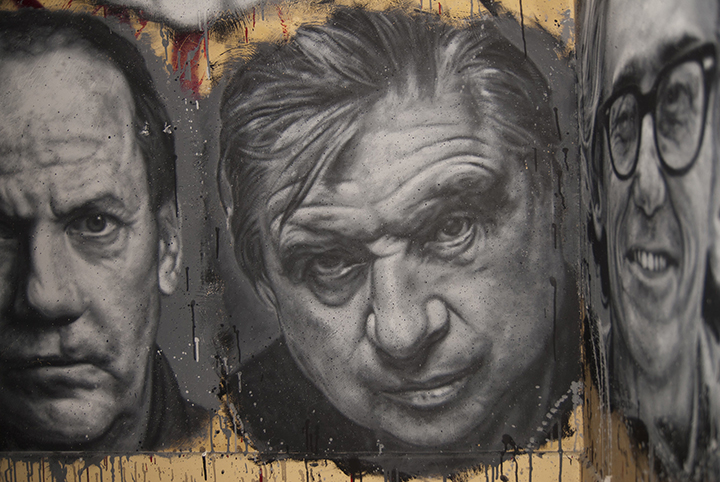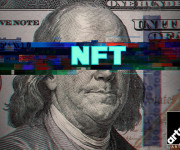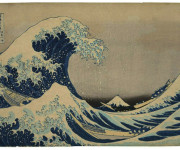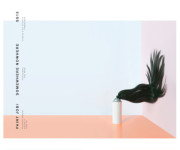On 29 June 2020, the charismatic Sotheby’s auctioneer, Oliver Barker, brilliantly orchestrated – alone in front of an audience of screens – the sale of Francis Bacon’s triptych Inspired by the Oresteia of Aeschylus (1981) for $84.55 million. This result was particularly reassuring for the Art Market… and was not without risk. In October 2017, Christie’s had failed to sell Bacon’s Study of Red Pope 1962. 2nd Version (1971) in London… a painting that was hoped to set an all-time European art auction record at over $90 million.
Following the cancellation of all the major fairs and spring sales, the high-end art market is clearly hungry. Apart from a couple of top-quality pieces offered in London auction rooms at the end of January (Tiepolo, Mantegna) and at the beginning of February (Hockney, Magritte, de Lempicka), the major collectors have had very little to chew on this year.

Collective work – Portraits of Richard Prince, Francis Bacon & Christo © Thierry Ehrmann 2020. Courtesy Contemporary Art Museum L’Organe / La Demeure du Chaos / Abode of Chaos ©
“There’s nothing more frustrating than being confined without being able to buy anything…” observes (somewhat ironically) Thierry Ehrmann, President and Founder of ArtMarket.com and its Artprice department… especially when you consider that money in the bank is so ‘expensive’ these days … Sure… this is a problem that only the wealthy face… but it’s one the auction houses have understood. This summer, some of them opened shop in the Hamptons where a lot New York collectors had taken refuge. Phillips presented a selection of works there that will soon be auctioned. Despite posting a heavy turnover contraction – down almost half for the first 8 months of 2020 – Phillips is back in 4th place in our global ranking and, above all, it is clearly preparing for the future”.
Phillips has also announced the creation of a brand new partnership with the leading Chinese art auctioneer, Poly Auction, whose sales turnover reached $617 million in 2019. But Poly Auction had a very difficult start to 2020, taking just $3.7 million in the first half (-99%), a situation it clearly hopes to reverse as quickly as possible via this alliance with the British auctioneer in Hong Kong, aimed at encouraging potential sellers to sell. “[This collaboration] provides a unique opportunity for consignees to leverage the combined customer base and marketing strength of two of the world’s largest auction houses” (1) says Jonathan Crockett, President of Phillips Asia.
Top 10 Fine Art Auction Houses (1 January 2020 – 31 August 2020). © artprice.com
Sotheby’s – $1.49 billion (-31%)
Christie’s – $1.03 billion (-54%)
China Guardian – $171 million (-31%)
Phillips – $164 million (-49%)
Xiling Yinshe – $76.3 million (+ 18%)
Bonhams – $54.5 million (- 32%)
Artcurial – $36.5 million (-30%)
Ketterer Kunst – $31.8 million (+ 5%)
Dorotheum – $27.1 million (-24%)
Mainichi – $22 million (-35%)
At the opposite end of the scale, some operators have apparently benefited from the health crisis (Xiling Yinshe and Ketterer Kunst). The German auctioneer Ketterer has posted 5% growth versus the same year-earlier period. With long experience in online sales, it managed to maintain interest and trading throughout the lockdown period, hosting one or two “Online-Only” sessions every month between January and June. In July 2020, it conducted four physical sales in Munich, taking a total of $29.5 million. In all, it was Ketterer’s best first-half period in its business history.
“We owe this success not least to our 65 years of experience,” says Robert Ketterer, auctioneer and owner of Ketterer Kunst. “We can interpret the signs and immediately react to even the slightest market changes with great flexibility, despite our very stable structures. As a digitalization pioneer, we have been successfully holding Online Only Auctions since 2007. In our 500th auction, an online bid in the millions was submitted for the first time ever.”
Robert Ketterer continues: “Ketterer Kunst has become established as the international specialist for art from the German-language region. We know exactly what potential buyers are looking for and always identify the perfect auction setting for every single artwork. This is also reflected by the continuous development of our auction catalogues and the Online Only Auctions, as we do not just adapt structure and content to latest market requirements, we also understand to stir desires with our unique range of quality objects.”
In this delicate period of accelerated transition to digital business against the backdrop of the health crisis, online sales are not yet the perfect solution for all segments of the art market. They are not automatically appropriate for all price ranges, all mediums and all artists. A more flexible bricks & clicks approach combining the various sales channels (physical, online, private) seems to be the best strategy in the medium term. And this new approach to value creation seems to rely increasingly on an idea we have been promoting for many years: selecting the right work from the right artist at the right time, in the right catalogue, and, via the most appropriate sales channel.
Artmarket and its Artprice department were founded in 1997 by its CEO, Thierry Ehrmann. Artmarket and its Artprice department are controlled by Groupe Serveur, created in 1987.






